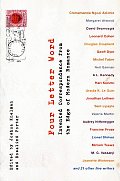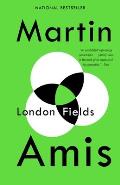
Perhaps the most common question I get asked, as an editor at
Granta magazine, is: "Does
Granta still do themes?" We do. We
still do themes, although the idea behind the original concept has matured and developed somewhat since the first revitalized issue of the old Cambridge University student magazine was published in 1979.
In his introduction to that issue, Granta 1, Bill Buford stated that American fiction was way ahead of its British counterpart. "Current British fiction seems," he wrote, "to be characterized by a succession of efforts the accomplishments of which are insistently, critically, and aesthetically negligible." On the other hand: "American fiction," since the Second World War, "has emerged as some of the most challenging, diversified, and adventurous writing today." Out of those claims, a theme was born ? "New American Writing" (and subsequently revisited in a slightly different incarnation in Granta 3: "The End of the English Novel"). But the theme of Granta 2 came out of an entirely different editorial impulse. "The Portage to San Cristobal of A. H." hardly sounds like a "theme," yet there it is on the front cover of Granta 2, with no other accompanying text aside from the magazine's logo and the name "George Steiner." It's the title of the lead piece in that issue (it's also very much the longest). Rather than commissioning writing to a theme, Buford took the decision to have Steiner's piece become the theme insofar as it gave the issue its title and also, following the huge critical acclaim after publication, its notoriety.
 Since 1979, Granta's themes have been thrillingly eclectic, but their variety isn't always the result of a group of editors sitting down together and coming up with a list. Rather, the diversity and scope of the theme is a function of the range and depth of the features themselves, some of which don't always appear to "fit" the theme. In Granta 25 ? "The Murderee" ? an extract from Martin Amis's novel London Fields sat firmly in between a piece by later Granta editor Ian Jack on the murder of three members of the IRA active-service unit killed in Gibraltar, but also a series of comic shorts by Todd McEwen set in a dismal Scottish pub. There is, as far as I recall, absolutely no mention of murder (even at the most elusively abstract and figurative level) in McEwen's piece. Similarly "Confessions of a Middle-Age Ecstasy Eater" (Granta 74) kicked off an issue that included a piece on fishing in Sweden: nothing remotely narcotic about that. Granta 15 is another example of a piece-based issue ("The Fall of Saigon" by James Fenton inhabits over a quarter of the magazine's space), as is Granta 45 ? "Gazza Agonistes" ? in which some 113 pages are taken up by Ian Hamilton's moving and brilliant tribute to the footballer.
Since 1979, Granta's themes have been thrillingly eclectic, but their variety isn't always the result of a group of editors sitting down together and coming up with a list. Rather, the diversity and scope of the theme is a function of the range and depth of the features themselves, some of which don't always appear to "fit" the theme. In Granta 25 ? "The Murderee" ? an extract from Martin Amis's novel London Fields sat firmly in between a piece by later Granta editor Ian Jack on the murder of three members of the IRA active-service unit killed in Gibraltar, but also a series of comic shorts by Todd McEwen set in a dismal Scottish pub. There is, as far as I recall, absolutely no mention of murder (even at the most elusively abstract and figurative level) in McEwen's piece. Similarly "Confessions of a Middle-Age Ecstasy Eater" (Granta 74) kicked off an issue that included a piece on fishing in Sweden: nothing remotely narcotic about that. Granta 15 is another example of a piece-based issue ("The Fall of Saigon" by James Fenton inhabits over a quarter of the magazine's space), as is Granta 45 ? "Gazza Agonistes" ? in which some 113 pages are taken up by Ian Hamilton's moving and brilliant tribute to the footballer.
So what is the reasoning behind the decision to theme an issue and then fill it with work that is seemingly unrelated to that theme? To return to Buford's early introduction in Granta 1 once more, "The issue we have organized has developed less from a specific principle of selection than a more general one of general collection." The themes, in other words, organize the issue, but the pieces constitute it. Regardless of any given thematic title, if the editors are excited by a piece of writing and feel it meets the literary standards Granta has upheld for all these years, it will be considered.
Granta's more specific thematic moments include "Food" (Granta 52), "Australia" (70), and, most recently, "Fathers" (104). These more particular themes serve to focus an issue and guide our commissioning, but their specificity is never at the expense of breadth. In "Fathers," David Goldblatt and Jonathan Lethem write movingly about their fathers, while Ben Markovits recalls how his old basketball coach was a kind of father figure to him, and Siri Hustvedt examines types of literary fatherhood. With these more concrete themes, our commissioning process involves a lot of attention to making sure each piece addresses the theme from a unique angle so there is no danger of overlap.
What I always think of as the more "transcendental" themes (i.e., those that are more ambiguous and inherently mysterious) include "What Young Men Do" (Granta 62), "Life's Like That" (82), and our latest issue, "Lost and Found" (105). It's not easy to imagine the pieces that might appear in issues governed by these seemingly random themes, but that ? to my mind ? is part of the fun: not knowing exactly what you are getting. Ian Jack offered what can only be described as an unapologetic non-explanation of how "What Young Men Do" works as that issue's theme in a fleeting moment at the end of his introduction (in which, it must be added, he spent two lengthy paragraphs discussing the magazine's redesign and offering some expository information about the strap line before addressing the issue of the intangible theme). "Two parlous states receive intimate examination in this issue: the first is marriage, the second Indonesia." If there appears, at first sight, to be an incongruity between the topics of marriage and Indonesia, opening the issue and reading the work dispels any sense of inconsistency. And that's because, regardless of the theme, every issue of Granta is thought about for (and often edited over) a long period of time, and when it comes to selecting the final line-up, we choose pieces that complement one another in mutually illuminating ways (that balance the issue and extend its range) via a process less concerned with "a specific principle of selection" than, to quote Buford one last time, a "more general one of general collection." "Life's Like That" is another example of a transcendental theme. What exactly does that mean? With a brilliant piece by Lynn Barber on being seduced by an older man, which has been made into the soon-to-be-released feature film An Education, and Simon Gray on why Gary Cooper walked the way he did, it's an issue about, well… a rather large subject ? life ? and will leave you thinking, "Ah yes, now I see...life is like that."
Perhaps the second most common question I get asked is, "How do you come up with themes?" and since I hardly really know myself, I shall save that for a later blog.